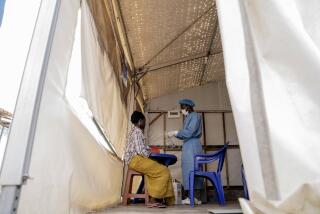U.S. Expected to Alert Doctors, Public About Cholera : Medicine: Americans will be asked to watch out for signs and symptoms of the disease.
- Share via
WASHINGTON — Federal health officials, while emphasizing that they do not expect a major outbreak of cholera in this country, are expected to warn U.S. physicians and the public at large today to be on the alert for signs and symptoms of the disease.
“We don’t need to alarm people, but they should be aware of the symptoms,” Dr. James O. Mason, assistant secretary for health, said in a recent interview. “If we do everything we should be doing, it won’t be a serious problem here.”
The burgeoning cholera epidemic has struck hundreds of thousands of people in Latin America since the beginning of the year, and several hundred cases already have been reported in Mexico.
As of Monday, the federal Centers for Disease Control had reported 15 cases in the United States from the same strain that has ravaged Latin America. These cases involved Americans who had traveled to Latin America or had consumed crabs that had been cooked in Ecuador, brought into the United States in personal luggage and later eaten in crab salad. There has been no secondary spread reported from these cases, CDC said.
“Cholera can be a severe, life-threatening illness that is highly preventable and easily treated,” said Mason, who also heads the U.S. Public Health Service. “However, few health care practitioners in the United States have experience with cholera.”
The information was scheduled to be released in today’s issue of Morbidity and Mortality Weekly Report, a CDC publication with widespread distribution in the public health community. The CDC also plans to circulate additional written materials and videotapes for health officials with information on the appropriate diagnosis and treatment of the illness.
A memo written by health officials at the Department of Health and Human Services said that the “future course of the epidemic is unpredictable,” but speculated that it could progress as it did in Africa after its introduction there in 1970.
“In Africa, cholera spread to 29 countries in 18 months, and it has persisted as a major public health problem for more than two decades,” the memo said. “The experience thus far in Latin America suggests that cholera will continue to spread and that it may persist indefinitely.”
Mason, who has met with Mexican health officials in recent days to discuss the growing epidemic, described the disease as preventable and treatable, and declared: “No one should die of cholera. Only those who don’t get care die. The rest survive.”
The disease typically is spread through food and water contaminated by the fecal matter of the infected, especially in regions lacking sanitary sewage and water purification systems.
Proper treatment of sewage and drinking water in the United States makes transmission via those routes unlikely here. But the danger still exists because of “considerable travel” between Latin America and the United States and because a strain of the bacteria is known to be prevalent in the Gulf of Mexico along the coast of Louisiana and Texas, the government said.
The latter strain, considered less virulent than the Latin American type, has been the source of 65 cases in the United States since 1973. Most of them have been related to the consumption of raw and undercooked shellfish illegally harvested from the Gulf of Mexico.
“We have cholera organisms in our own streams and rivers, and people will be at risk if they are taking shellfish out of areas they’re not supposed to,” Mason said. “Also, we have tourists coming back (from Latin America) who need to be aware of this.”
With “awareness of signs and symptoms of cholera and knowledge of appropriate treatment, cholera should not pose a major health risk in the United States,” Mason said.
The CDC guidelines say that “cholera should be suspected in a patient with severe watery diarrhea, vomiting and severe dehydration.” The illness is also often accompanied by “marked” leg cramps, which are caused by electrolyte disturbances, CDC said.
“Clinical suspicion should be increased for persons returning from areas known to have epidemic cholera or for persons with a recent history of ingestion of raw or undercooked shellfish,” the CDC said.
The disease is treated by replacing lost fluids and electrolytes and administering antibiotics. If treatment is not available, however, the disease can be fatal.
The latest cholera epidemic appeared almost simultaneously in several cities on the Peruvian coast at the end of January. The initial source is unknown.
Since then, cholera has spread to Ecuador, Colombia, Chile, Brazil, Guatemala and Mexico. As of July 28, more than 270,000 cases and more than 2,900 deaths had been reported.






